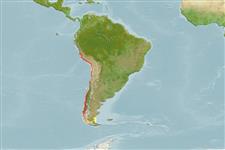Common names from other countries
Environment: milieu / climate zone / depth range / distribution range
экология
; пределы глубины 10 - 1138 m (Ref. 87391). Temperate; 11°S - 54°S, 78°W - 68°W
Southeast Pacific and Southwest Atlantic: Chile and Peru.
Length at first maturity / Size / Вес / Возраст
Maturity: Lm ? range ? - ? cm Max length : 15.0 cm CW самец/пол неопределен; (Ref. 78814); 11 cm CW (female)
Found on soft-bottom sublittoral habitats. Mainly epifaunal but can be considered a bioturbator as it reworks sediments. Notably disturbs the sea floor, exhibiting "sediment mining" behavior while in search of prey. Predatory (Ref. 106462).
Life cycle and mating behavior
половая зрелость | размножение | нерест | икра | Fecundity | личинки
Members of the order Decapoda are mostly gonochoric. Mating behavior: Precopulatory courtship ritual is common (through olfactory and tactile cues); usually indirect sperm transfer.
Основная ссылка
ссылки | координатор | соавторы
Gorny, M. 1999. (Ref. 87391)
Статус Красного Списка МСОП (Ref. 130435)
Статус СИТЕС (Ref. 108899)
Not Evaluated
Not Evaluated
Угроза для людей
Harmless
Использование человеком
рыболовство: коммерческий
FAO - рыболовство: landings | FishSource | Sea Around Us
инструменты
дополнительная информация
Возраст/РазмерыростЗависимость между длиной и массой телаЗависимость между длинамиморфологияличинкичисленность
ресурсы в Интернет
Estimates based on models
Preferred temperature
(Ref.
115969): 6.5 - 12.3, mean 9.4 (based on 36 cells).
